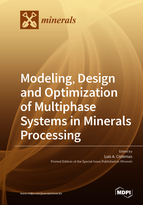Modeling, Design and Optimization of Multiphase Systems in Minerals Processing
A special issue of Minerals (ISSN 2075-163X). This special issue belongs to the section "Mineral Processing and Extractive Metallurgy".
Deadline for manuscript submissions: closed (31 March 2019) | Viewed by 58197
Special Issue Editor
Interests: modeling; design; optimization; uncertainty; flotation; heap leaching; tailing; seawater
Special Issues, Collections and Topics in MDPI journals
Special Issue Information
Dear Colleagues,
Mineral processing deals with complex particle systems with two-, three- and more phases. The modeling and understanding of these systems are a challenge for research groups and a need for the industrial sector. This Special Issue aims to present new advances, methodologies, applications, and case studies of computer-aided analysis applied to multiphase systems in mineral processing. This includes aspects such as modeling, design, operation, optimization, uncertainty analysis, among other topics. The articles can be general about multiphasic systems or specific phenomena such as flotation, leaching, solvent extraction, thickening, multiphase flow, among others that include the simultaneous presence of several phases. Articles that may be of interest to a general audience are preferred over more specific or reduced audience, and therefore, multidisciplinary, interdisciplinary, and cross-disciplinary studies are welcome.
Prof. Dr. Luis A. Cisternas
Guest Editor
Manuscript Submission Information
Manuscripts should be submitted online at www.mdpi.com by registering and logging in to this website. Once you are registered, click here to go to the submission form. Manuscripts can be submitted until the deadline. All submissions that pass pre-check are peer-reviewed. Accepted papers will be published continuously in the journal (as soon as accepted) and will be listed together on the special issue website. Research articles, review articles as well as short communications are invited. For planned papers, a title and short abstract (about 100 words) can be sent to the Editorial Office for announcement on this website.
Submitted manuscripts should not have been published previously, nor be under consideration for publication elsewhere (except conference proceedings papers). All manuscripts are thoroughly refereed through a single-blind peer-review process. A guide for authors and other relevant information for submission of manuscripts is available on the Instructions for Authors page. Minerals is an international peer-reviewed open access monthly journal published by MDPI.
Please visit the Instructions for Authors page before submitting a manuscript. The Article Processing Charge (APC) for publication in this open access journal is 2400 CHF (Swiss Francs). Submitted papers should be well formatted and use good English. Authors may use MDPI's English editing service prior to publication or during author revisions.
Keywords
- Modeling
- Design
- Optimization
- Operation
- Flotation
- Leaching
- Solvent extraction
- Thickening
- Multiphase flow






